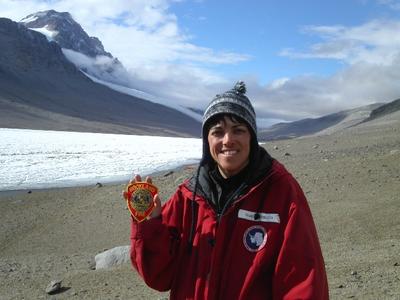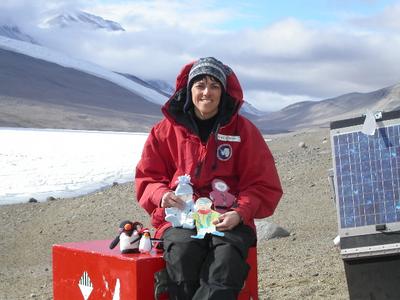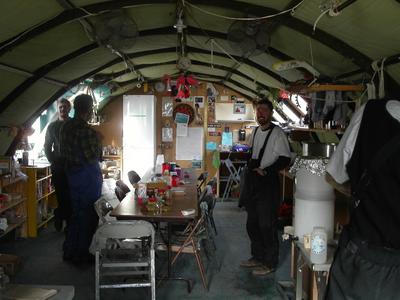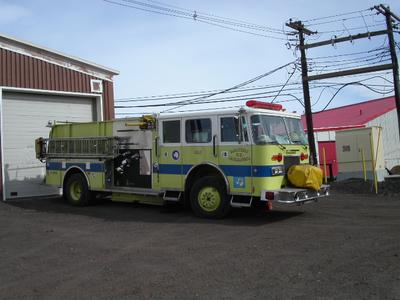14 January, 2003
Responses to E-Mails
Today only part of the team was needed out on the ice, so I was given the
day to continue catching up with my journal entries and to try to get
through some e-mails. I don't have time to respond to the overwhelming
number I have been sent, but I am so pleased to see that so many people have
taken an interest in this adventure and research. I hope you are all
finding my journal entries enjoyable, and that I am being descriptive enough
to paint a picture of life here.
I would like to devote today's journal to answering some of the questions I
have received in my e-mails. Please forgive me, but to be efficient with my
limited computer time, my responses to your questions will be in no
parcticular order... just sort of a potpourri of Antarctic information.
JOURNAL DELAYS: First I'd like to explain why there are long gaps between
journal entries. I am in a remote campsite and do not always have access to
the Internet. When I was at Lake Fryxell, it was a 40-minute walk to the
Lake Fryxell F6 Camp where they had a hook up, but I was not always free to
travel there. This week we are at Lake Bonney and we were lucky enough to
set up camp near the established Bonney Camp where again I have access to
the Internet. This week may end up as my last week to do my journal entries
on my own. After that, I will be relying on helicopter pilots to deliver my
journal entries on a disk to someone back at McMurdo Station who will then
post them for me. I appreciate your patience in waiting for these postings
and I will do my best to make them "worth the wait".
FIRES: I've had questions from a few people, including Don from the RFD,
regarding fires in Antarctica. McMurdo does have their own fire department
and they are not volunteer firefighters. I think they work on two shifts,
but I am not sure yet. I did meet some fire fighters at dinner one night
and told them I would like to go to the station for a photo with the RFD
patch. They were more than willing to accommodate me, so that is on my "to
do list" for when I return to McMurdo. I do know that fire is of great
concern here because it is so dry, our shelters are so critical to survival,
and because water (in liquid form) is not easily accessible. In one of our
briefings, the importance of reporting even the smallest fire or potential
fire was stressed and reinforced at various times.
We do not have campfires around our tents at night. There are no trees, so
there is nothing to burn here. Plus again, it would be too dangerous. We
use camp stoves and are very careful when lighting them and monitor them.
We have fire extinguishers in our cook tent ready for an emergency.
SUNBURNS: The sun is very bright here and you need your sunglasses even on
cloudy days. We all apply sun block several times a day to protect our
skin. I am lucky in that I personally do not tend to burn easily, but some
members of my group, despite the sun block, have burned a bit. We are all
starting to look like raccoons as our sunglasses maintain white circles
around our eyes, while our cheeks turn bronze.
ANIMALS: I have not seen any live animals here. The animals are all near
the open water where they can get food from the ocean. Sometimes, seals and
penguins become disoriented and will wonder far inland (over 15 miles).
Sadly, these animals usually die because there isn't food available for
them. There are not any land animals in Antarctica (except a wingless fly
that lives near the coast) unlike the Arctic, which has bears, hares, foxes,
musk oxen and much more. Many people think polar bears live here in
Antarctica having been misled by cartoons and movies, but polar bears are
only in the Northern Hemisphere, just as penguins are only in the Southern
Hemisphere. I have come across some remains from seals, which can be as old
as 4000 years, and have posted some photos in my journals.
STAYING ORIENTED: Is it easy to get lost? Walking from place to place
could get confusing if you do not orient yourself when you arrive. During
snow school the instructors stressed to us that when you arrive in a
location, become familiar with the area. Take a good look at the mountains,
glaciers, etc. Identify certain geological features that you can use to
orient yourself. I have not been traveling great distances. Even a four
hour walk in one direction here doesn't change your perspective of the
mountains and such very much because everything is so incredibly big. A
glacier may look like it is a ten minute walk away when; in fact it may be a
three hour walk. As I took my 40 minute walk to F6 everyday from our camp,
I just kept Lake Fryxell on my left and knew I had to cross three streams
before I reached the hut.
The research team does carry a GPS to connect to polar satellites that
recognize our exact position and provide us with our location coordinates
(longitude and latitude). This way we can record our exact drilling sites
or rock/mineral collecting sites.
WEIGHT LOSS & EATING: I don't know if I have lost or gained weight. I feel
about the same right now, but putting on a regular pair of pants would
answer that question quite quickly. It is hard to tell in these bib wind
pants and I won't have on regular pants until I return to New Zealand. For
breakfast, oatmeal or granola cereal and powdered eggs are generally
available. On Sunday's, the treat is pancakes. Sometimes Chris cooks up
bacon (like Canadian style bacon), which is a nice treat. At lunch it is
always the same... cabin bread (like square milk crackers) with peanut
butter and jelly, a candy bar, and your choice of tea or hot cider, as we
always carry thermoses of hot water in our backpacks.
It is important to drink plenty of fluids because it is easy to become
dehydrated. Antarctica is a dry environment with a constant wind, and you
do work up a sweat when you work, which is quickly evaporated so we are
careful to drink frequently.
ANTARCTIC MASCOTS: The following characters have traveled to Antarctica
with me:
From Rockland, Tux the Penguin.
From Dighton Middle School, Paul the Penguin
From Grade 1 at Jefferson School: Fleece Flat Stanley, Pink Flat Stanley,
and Colorful Flat Stanley. They are all doing well and enjoying their
visit.
NEWS: We receive some news almost every night. When Chris does the nightly
call into Scott Station (New Zealand Station) we are told the day's
headlines. Then if there is something we would like more information on,
the communications operator will read us the entire arcticle. We don't get a
great deal of news, but at least we feel we can stay in touch with the
outside world. I could also go on line to get some news, but as of yet, I
have not had the luxury of spare time to do that.
E-MAIL CONTENT: I am trying to touch on a variety of topics to capture the
interest of various people at different age levels. I realize some days my
entries may contain information about the science that is difficult to
follow, but I am trying to explain our research and activities in such a way
that everyone can gain a little something from each journal entry. I will
also try my best to describe life here on the Ice.

Rockland Fire Department represented in Antarctica. I'm standing outside of Bonney Hut Camp. That's Lake Bonney in the left of the photo and the LaCroix Glacier coming down from the mountain.

Hanging out near Lake Bonney with penguins Tux and Paul, along with Fleece, Colorful, and Pink Flat Stanleys. Note the solar panel on the right that helps to power the jamesway shelter.

This is our typical lunch. P&J on cabin bread, a chocolate bar, and Raro (NZ version of Kool-aid)

A view of the jamesway hut here at Lake Bonney. Our stay here is brief, so we are savoring every luxury contained inside this arched canvas structure. From L to R... that's Jake, Chris, and Sean.

Fire engine at station house in McMurdo.
Contact the TEA in the field at
.
If you cannot connect through your browser, copy the
TEA's e-mail address in the "To:" line of
your favorite e-mail package.
|
